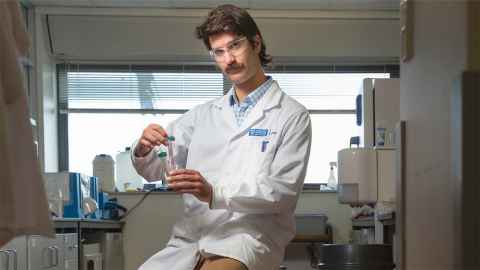Take 10 with... Joel Rindelaub
Dr Joel Rindelaub, Research Fellow from the School of Chemical Sciences, gives us 10 minutes of his time to discuss his research.

1. Describe your research topic to us in 10 words or less.
I measure pollution and waste in our air and environment.
2. Now explain it in everyday terms!
I measure pollution and waste in our air and environment.
3. Describe some of your day-to-day research activities.
Sometimes I get to go on adult field trips to monitor air pollution in magical places, like Henderson in West Auckland. But mostly I’m either meeting with students, sitting in front of a mass spectrometer, or on my computer trying to convince complete strangers to fund my research.
4. What do you enjoy most about your research?
I like teaching students how to be analytical chemists and then watching them get the job of their dreams.
On a more personal level, I enjoy discovering new sources of pollution. It’s really exciting but also really scary. An emotional amalgamation you just can’t get anywhere else!
5. Tell us something that has surprised you in the course of your research.
During the Sky City Convention Centre Fire in 2019, I was worried that no one was going to capture the massive amount of air pollution that was being generated in New Zealand’s most densely populated area. So I did what any inquisitive scientist would do - I filled my car with sampling gear, drove it into the fury, and left everything overnight in a carpark.
When I returned the next day, not only was my car still there but the samples I took were by far the dirtiest I had ever seen in my life. All I could muster was “HOLY SMOKES”... It wasn’t until much later that I realised how apt my description was. My samples ended up being the only ones taken in proximity to the site, showing extremely high levels of carcinogens present in the air that Aucklanders were breathing. Quite the surprise indeed.
6. How have you approached any challenges you’ve faced in your research?
As an early career researcher, my biggest challenge has been securing funding. I have overcome this challenge by applying for more funding.
7. What questions have emerged as a result?
Why won’t anyone fund me? Is my research important? What am I doing with my life?
Just kidding, only one of those is true.
8. What kind of impact do you hope your research will have?
I try to design my research to answer questions directly related to human health and the environment, ultimately raising societal awareness and helping inform public policy.
For instance:
Q. Do Guy Fawkes celebrations contribute to air pollution? A. Yes, significantly.
Q. Are unapproved drugs in NZ dietary supplements? A. Yes, in breach of the Medicines Act.
Q. How many microplastics are in the water I’m drinking? A. More than you would want.
9. When you collaborate across the faculty or University, or outside the University, who do you work with and how does it benefit your research?
My biggest collaborator is Associate Professor Gordon Miskelly (School of Chemical Sciences), so a big shout out to him. Working under Gordon has been highly beneficial because he has invaluable analytical chemistry expertise that has helped make my research a reality.
Outside the University of Auckland, the air quality community has been very helpful, including Dr Perry Davy (GNS), Dr Nick Talbot (now at UOA), and the Auckland Council. Here at the University that includes Professor Jenny Salmond (School of Environment), Associate Professor Kim Dirks (Environmental Engineering), and Hamesh Patel (School of Environment). We are always looking for innovative ways to assess air quality and its impacts on New Zealanders.
10. What one piece of advice would you give your younger, less experienced research self?
Write more papers.